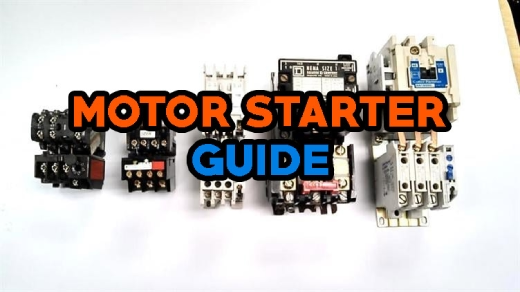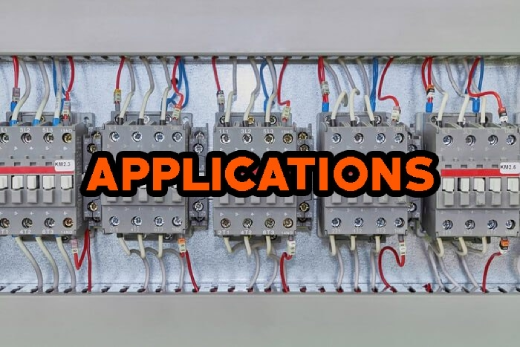What is Motor Starter? Types of Motor Starters and Applications
There's no such thing as a motor starting on its own, it needs a little push, a controlled boost. The motor starter comes into play here. Power is handled by them, circuits are protected, and everything is kept running smoothly. Those components could be damaged by surges, causing the system to overheat, burn components, and cause failures. They come in various types, each suited for a particular purpose. Soft starts are offered by some companies, while full voltage is provided instantly by others. Everywhere you look, motor starters make machines more efficient, reliable, and safe. How do you choose the right one? Depending on the motor, the load, and the level of protection required. You can also learn about: How Does a Single Phase Motor Work?

What is Motor Starter?
The motor starter is more than just a switch; it's a safety feature. There is no such thing as a sudden power surge that motors like, they demand control. Without one, how can the switch be flipped? This massive current overheats the wires, stresses the circuits, and may even burn out the motor. It's for that reason that starters exist, to regulate and protect. The overload protection on some of them prevents real damage from occurring before it is too late. The only chance is to respond immediately. Maintaining motors this way prevents costly repairs and keeps them running longer.
Different types of jobs require different skills. Other motors take their time to reach full power, which reduces stress and prolongs the motor's life. What about factories, elevators, HVAC systems, even your air conditioner? Each of them relies on a starter. If you don't start smoothly, you won't run smoothly. It is necessary for industrial machines to be precise, to accelerate smoothly, and to be safe. Those are the benefits of motor starters. In motor-driven systems, it is more than just a simple device.
Applications of Motor Starter

Industrial Machinery
Take a moment to imagine a vast factory floor humming with machines. Powered by motor starters, each of them is powered by a motor. What would happen without it? Overheating, overcurrent, and possibly a burnout could occur. In order to keep things running smoothly, starters make sure conveyor belts, pumps, and drills get started. In this country, Direct-On-Line (DOL) starters are commonly used. They are simple, yet effective. It takes just a few presses to start this machine. There's no drama, no fuss.
Water Pump Systems
Are you ever curious about how water is pumped up tall buildings? The motor starter is one of the unsung heroes in the world. Having a smooth start is important for water pump motors - too much current at once may lead to problems. It is essential to protect against overload. As well as farmers, they use deep wells for drawing water. In some instances, star-delta starters are used to reduce the load, slowly ramping up power as the load increases. Flowing smoothly without sudden jerks. Water is essential to cities, farms, and homes. How does it get there? This is a motor starter in action.
HVAC Systems
A blazing summer day without air conditioning? A motor starter is to be thanked. Cooling spaces and moving air is done by big motors in HVAC systems. The motor is eased into action with a soft starter. A flickering light might cause circuits to trip, and the motor may wear out more quickly if this is not avoided. Did you ever experience a slight delay when turning on an air conditioner? All that's happening behind the scenes is the starter making sure everything is running smoothly. A small detail can make a big difference.
Elevators and Escalators
The moment you step into an elevator and press the button, bang! ——it jolts. That's not pleasant, is it? It is for this reason that motor starters are so important. Using them prevents sudden jerks and ensures smooth, gradual movement. Regulating speed is often achieved with soft starters or variable frequency drives (VFDs). A graceful escalator glides, a graceful elevator ascends. You won't experience any sudden shocks. Wouldn't want to spill that coffee, would you?
Automotive Applications
Motor starters are essential for both factories and buildings, as well as cars and trucks. Take a look at electric vehicles. Batteries must be protected from overload by a controlled start for the motors. In hybrid systems, they enable seamless switching between electric and fuel-powered modes. Do you drive a big truck or bus? Those heavy-duty motors are protected from overpowering with starters. There would be far more breakdowns if they weren't there. Is there anyone who wants that?
Mining and Oil Industries
There are motors everywhere, in the mines as well as in the oil fields. Every machine needs power, whether it's a pump, drill, or conveyor belt. The key to surviving in these harsh environments is protection. Motor starters can handle dust, moisture, and extreme temperatures. As a result, overloads are prevented and steady operation is ensured. Could it be a single failure? It could cost millions of dollars. Hence, rugged, durable starters are essential in these industries. It's more than just a piece of technology, it's a lifeline.
Textile Industry
You can imagine a textile mill that spins, weaves, and dyes. It's a never-ending cycle of machines and motors. What if there were no motor starters? A chaotic situation. The threads snap, the looms jam, and the motors overheat. For delicate operations, factories use soft starters instead of DOL starters. Reducing wear and tear and preventing jerks in the machines. The start was smooth, the rhythm was steady. It's that process that makes those soft t-shirts and snuggly blankets.
Food Processing Plants
What goes into making your favorite snacks? Each conveyor belt, mixer, and slicer has a motor inside. Where do those motors come from? Starters, keeping them safe. Processes involving food require precision. A soft starter makes it easier for blenders and mixers to start smoothly, preventing spills and mess. Star-delta starters prevent overloading in high-speed slicers. Motor starters are used for everything from dough kneaders to juice extractors. In the same way as the chefs, they work hard behind the scenes.
Renewable Energy Systems
There's more to green energy than solar panels and blades. A wind turbine, for instance, or a solar farm. These systems have motors, don't they? Needs to be controlled. A wind turbine's starter prevents damage from sudden gusts. With solar tracking systems, panels follow the sun smoothly as they rotate. These motors would fail if not controlled properly, resulting in reduced efficiency. Providing clean energy requires smart technology, and motor starters play a key role. By starting small, we can make a big difference.
Different Types
Direct-On-Line (DOL) Starter
Simplest and most common type. The motor receives full voltage immediately after pressing a button. Rather than a gradual start, the power is instantaneous. Small motors? No problem. What about bigger motors? It gets tricky at that point. The sudden surge of current can cause voltage drops in the system when it is six to eight times higher than normal. The simplicity of DOL starters makes them ideal for applications such as fans, pumps, and compressors. The only components are a contactor, an overload relay, and a switch. It's basic, but it works.
Star-Delta Starter
Are you familiar with smooth operators? That’s a star-delta starter. In a star connection, the motor starts at a lower voltage and lower current instead of slamming in full power. At that point, it shifts to delta and delivers full voltage. Why? Due to the possibility of tripping circuits or overheating motors when inrush currents are high. High-powered compressors, conveyor belts, and large industrial machines use this method. In terms of efficiency, it is a bit more complex than DOL.
Autotransformer Starter
Special treatment is needed for big motors. A transformer starter can help in this situation. Using a transformer, they gradually increase the voltage rather than hitting the motor with a high voltage. Rather than shoving hard, think of it as a gentle push. By doing this, electrical circuits are less likely to be stressed and power supply dips are prevented. Often used in heavy-duty applications, such as crushers, turbines, and large pumps. More expensive? Yes. When it comes to large motors, it's often the best solution.
Soft Starter
Think about what would happen if you stepped on your car's gas pedal too hard; it would jerk forward, wouldn't it? Similarly, motors work. This is prevented by soft starters. Increasing voltage gradually reduces mechanical stress and electrical spikes, allowing motors to start smoothly. HVAC systems, conveyor belts, and fans benefit from this product. Also, they extend the lifespan of motors, resulting in less wear and fewer breakdowns. A smart, efficient, and protective system. Electric motors have something similar to cruise control.
Variable Frequency Drive (VFD)
It should be a full-on control system, not just a starter. Motor speed is controlled, torque is adjusted, and efficiency is optimized with VFDs. Are you looking for a conveyor belt that speeds up or slows down? VFD can do that. Are you looking for an industrial fan that can dynamically adjust airflow? VFD again. Various applications include elevators and high-tech manufacturing. What's the catch? Compared to other starters, this one is more expensive and complex. However, nothing beats it when it comes to precise motor control.
Rotor Resistance Starter (For Wound Rotor Motors)
Cranes, mills, and heavy-duty machinery use wound rotor motors, which need special care. Current is controlled by resistors in rotor resistance starters. Slowly reducing the resistance, the motor starts smoothly. When handling heavy loads, torque control is crucial. Materials handling and mining are industries that require more specialized skills.
Manual Motor Starter
Hands-on, old-school. Basically, a manual starter works the same way it sounds. You flip a switch to start or stop the motor. The unit is inexpensive, simple, and perfect for small applications such as workshops, fans, and pumps. Just a direct connection-no automatic controls, no fancy protections. In addition to overload protection, it's a plus if it's included. The job is done, but it is basic.
Final Verdict
The motor starter is an unsung hero in the world of electricity. Whatever the size and power of the motor, choosing the right starter is crucial. Each type of starter balances power, protection, and efficiency, from the simple DOL to the sophisticated VFD. The use of soft starters makes sure that high-power machines run smoothly, while the use of star-delta setups ensures their safe operation. Control is essential to preventing damage, improving performance, and maintaining smooth operations. Starters are more than just switches; they are safeguards, game changers, and sometimes, the difference between success and failure. Checkout more on: Blikai.com.
What is an Electric Motor? Explain its Types
Induction Motors: Working Principle and Types (Guide)
What L298 Motor Driver IC is :Pinout and & Applications
What is the DRV8825 Stepper Motor Driver? A Detailed Description
Different Types of Electric Motors All Explained
What L298 Motor Driver IC can do and How it Works
What is an Induction Motor :All You Need to Know
How Does a Single Phase Motor Work?
Do ECM Motors Have Capacitors?
Carbon Film vs Metal Film Resistor










